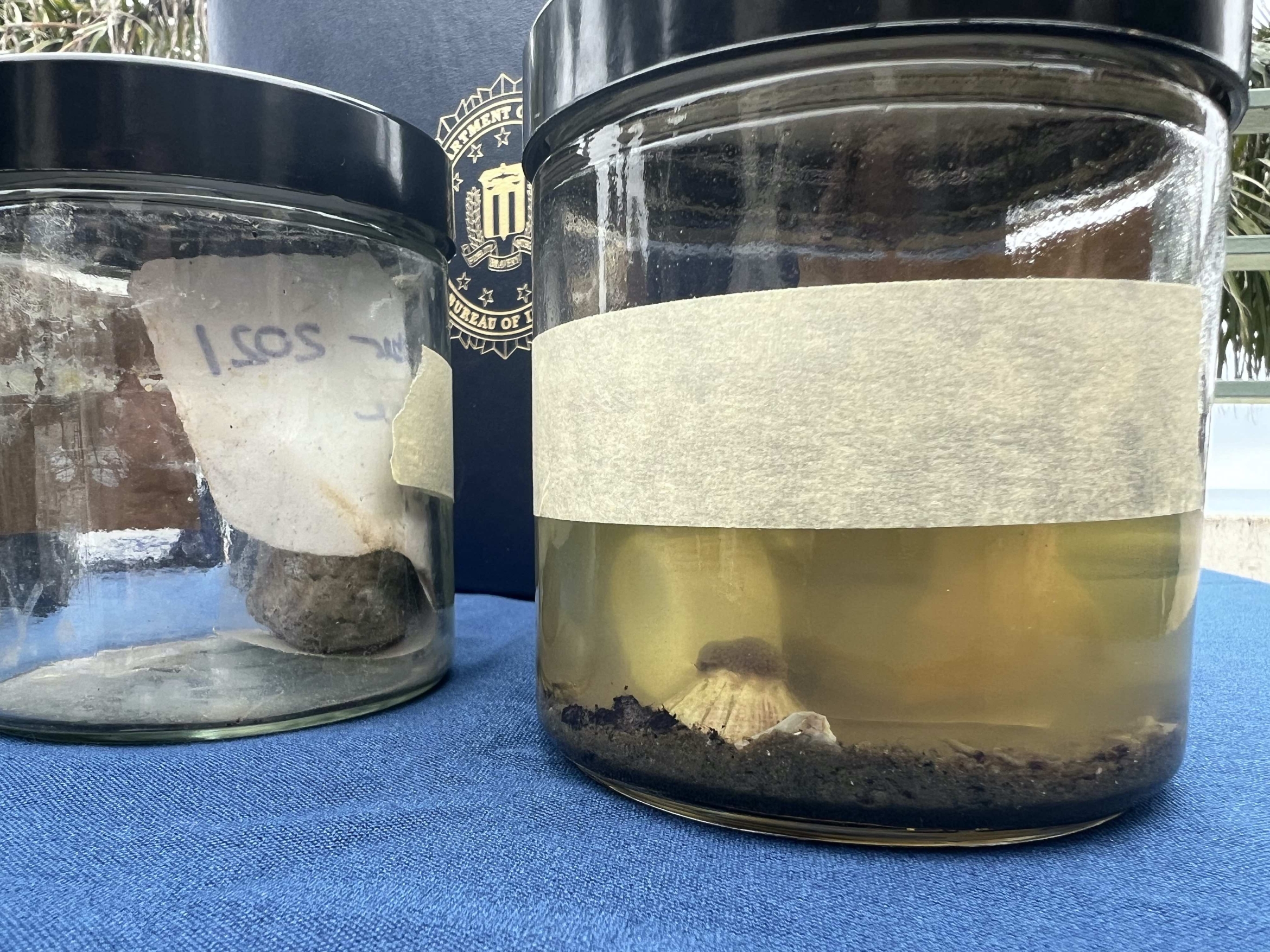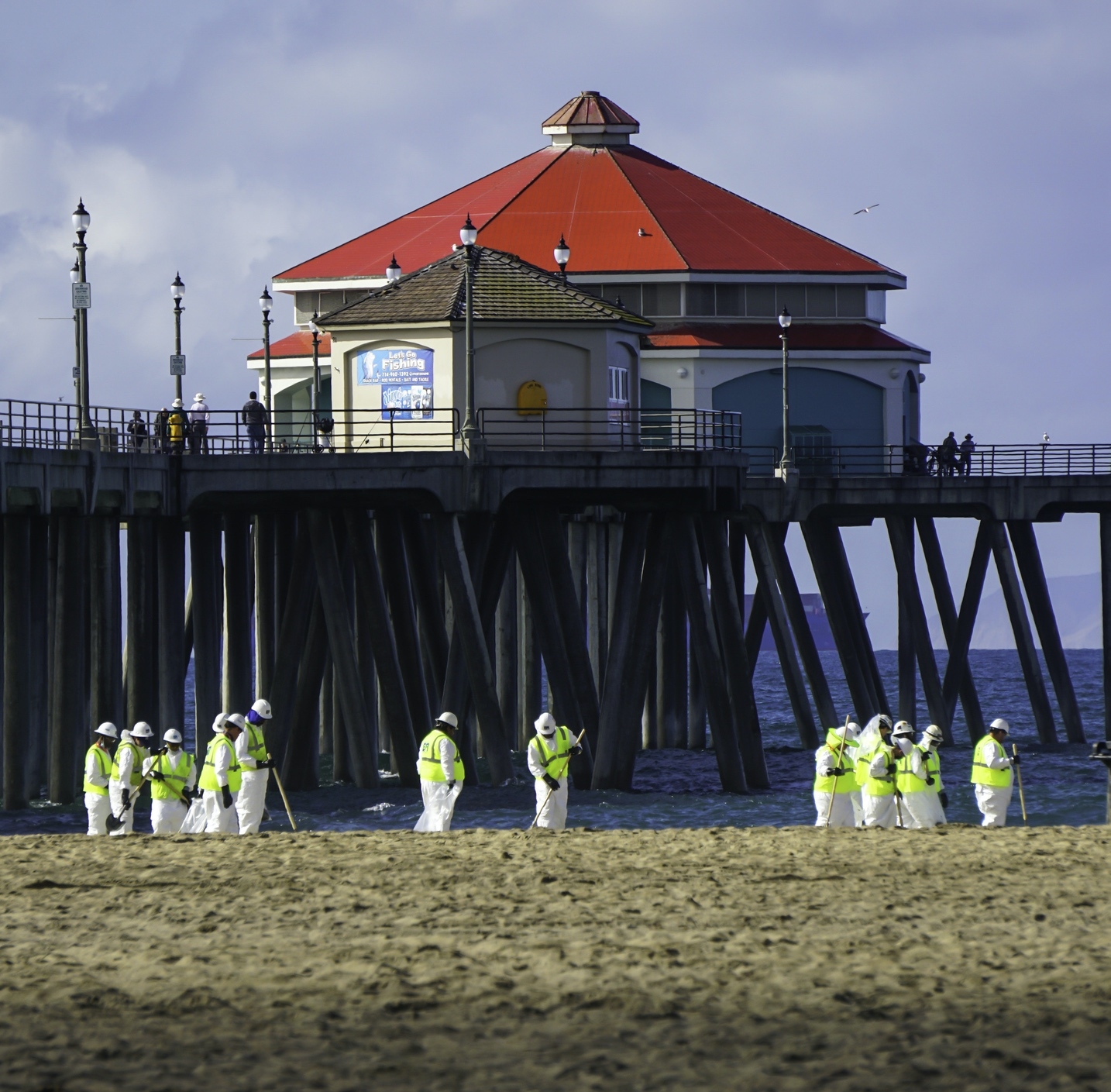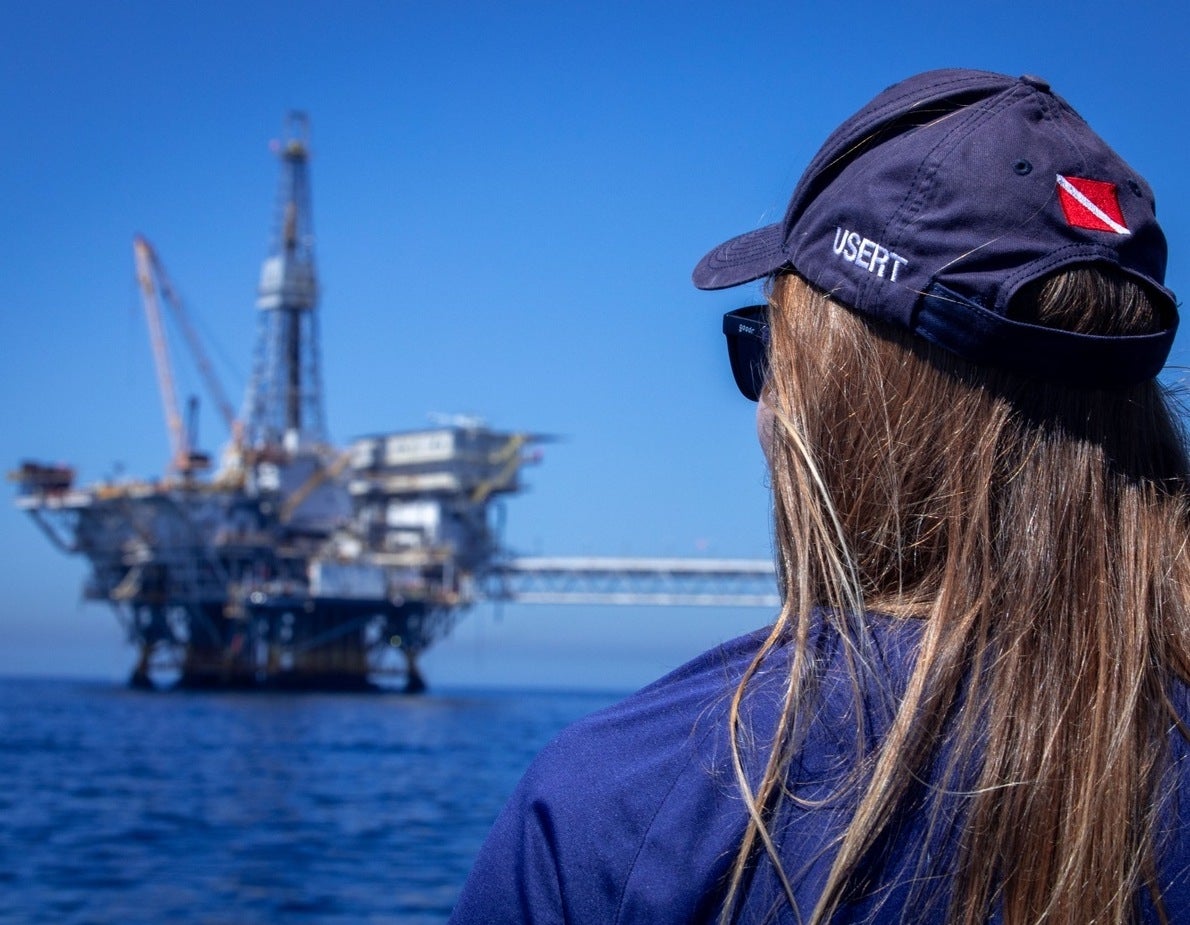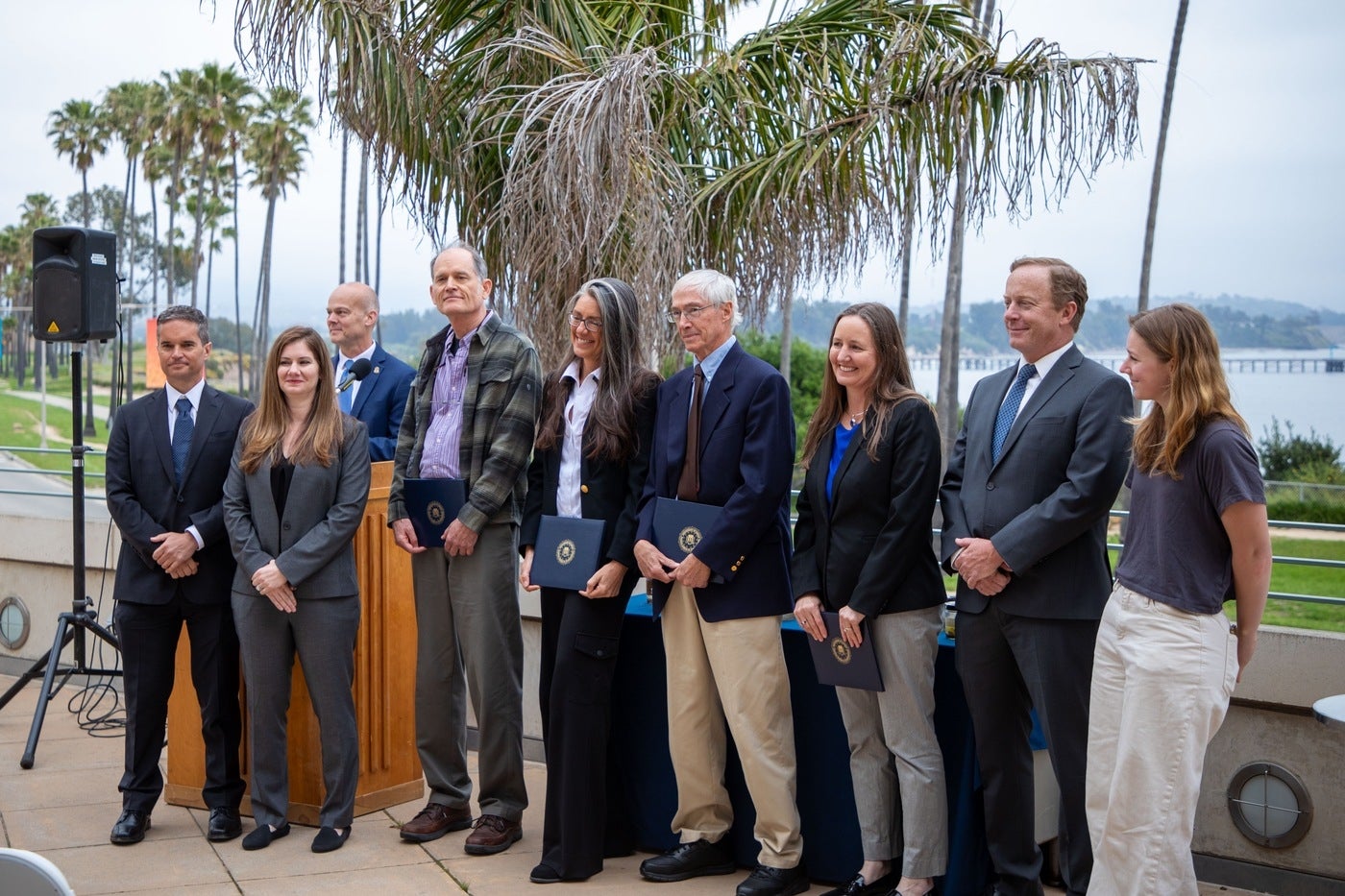
How Marine Science Institute researchers helped solve the 2021 Huntington Beach oil spill
Participating in a federal investigation was not on UC Santa Barbara marine biologist Mark Page’s agenda back in 2021, but after he got the call from the Coast Guard that October, he became part of a “dream team” of scientists and investigators that unraveled the mystery behind a spill that coated Huntington and Newport beaches with about 25,000 gallons of crude oil.
“Of course I was wondering how they got my name,” said Page, who thinks it was probably due to work he’d been doing in the area, studying invertebrate communities on oil platforms in the San Pedro Bay, just off the southern California coast near the ports of Los Angeles and Long Beach.
Page and his team are particularly interested in the dispersal of larvae of native and non-native invertebrates in the region and the connectivity of their populations between the platforms and nearby natural reefs. The work involves taking and analyzing samples on the platforms, the reefs and in the wider region to gain insight into whether platforms could facilitate the dispersal of these species to natural habitat and how the non-native species that live on the platforms could affect native reef-dwellers should they be dispersed to natural habitat.
He was engaged in this general research when the call came through, an urgent request to help solve a seafloor puzzle.
Following reports of an oil slick floating in the waters off Huntington Beach on Oct. 2, 2021, the Coast Guard sent down an unmanned vehicle to find and document the scene of the spill, revealing evidence of a break in the casing of an oil pipeline on the seafloor leading to one of the oil platforms. Led by Special Agent Ketrin Adam, the FBI Los Angeles Field Office had gotten involved due to the severity of the spill, which killed more than a hundred birds and polluted sensitive habitats in addition to closing area beaches and interrupting a popular airshow.

The FBI’s Underwater Search and Evidence Response Team (USERT) began by reviewing the video taken by the Coast Guard.
“Their working hypothesis was that the pipeline had been stretched by the anchors of cargo ships hooking on the pipeline and pulling it,” Page recalled. “The pulling created a stress that broke the casing that covered the pipeline, and that ultimately weakened or created a crack in it that several months later actually resulted in the spill.”
While the investigators had a good idea of what had happened and how, the next missing puzzle piece was when, information which could serve as evidence for a potential criminal case against who was responsible.

“We knew the anchor drag theory was plausible,” said Assistant United States Attorney Matt O’Brien at a recent FBI Director’s Award event honoring the team who solved the case. But, he said, it was still a “real riddle” to figure out who might have done it, and whether it was an accident or an intentional act. “We were trying to be creative and use the best minds out there,” he said.
Fortunately, there was a potential lead. In reviewing the Coast Guard’s footage, USERT team leader Ty Summers noticed the presence of marine invertebrates — tube worms and barnacles — that had grown on the broken concrete and exposed pipeline. The investigators realized that they might have a means for establishing a timeline of events, and Page’s expertise in marine invertebrates would play a major role.
“Essentially, it’s a forensic analysis, similar to what would be done in cadavers using insects,” Page said. In forensic entomology, he explained, the size and composition of insects found on a dead body can tell how long the body has been dead. Except in this case the “body” was the broken oil infrastructure and the telltale insects were the invertebrates. Because these creatures are sessile — their adult forms are fixed in a single place — the idea was that it would be possible to determine by their stage in development how long ago the pipe had been dragged.
“They have planktonic larvae,” Page explained. “When the concrete casing that surrounded the pipeline broke and exposed the bare pipeline, barnacle larvae that happened to be present in the plankton settled on the pipeline.” Because there is reliable information in the scientific literature on the barnacle’s growth rate, he added, it would be possible to trace backward with some accuracy how long the creature had been there.
Armed with that knowledge, the next step was to actually retrieve that evidence — no small feat, considering that the scene to investigate was deep underwater. Having paired up with scientific divers from the U.S. Bureau of Ocean Energy Management (BOEM), the USERT divers conducted a reconnaissance dive to “stake out” the scene. With Page’s help, they created a plan for another, more complex, evidence-gathering dive.
That task was left in the capable hands of BOEM divers Donna Schroeder and Susan Zaleski, who, along with the USERT team, carried out the exacting and time-limited process.
“The accident, or crime scene was around 104 to 108 feet deep, pretty deep for using standard scuba equipment,” Schroeder said. “For safety reasons, we had about 12 minutes per dive to get the work done and we could only make two to three dives per day.” Further complicating the situation was the dark and murky environment. A marine ecologist by training, Schroeder, now BOEM’s “most cited scientist,” is no stranger to UCSB’s Marine Science Institute. She studied under MSI founding member Alfred Ebeling, and worked as a staff research associate in the Milton Love Lab before moving to BOEM in 2007.
Working in 12-minute blocks under observation and videotaping by the USERT team, Zaleski and Schroeder painstakingly took samples from the scene, following a strict chain-of-custody protocol to ensure that the evidence was protected from contamination and tampering as they handed the evidence over to the FBI for them to give to Page.
“Personally, it was also a very rewarding project, and a great team effort,” she said.
Back at the lab, Page had recruited some help, in the form of undergrad Makenna Colucci.
“Makenna was very highly recommended to me as someone who I could count on to do a very careful, meticulous and enthusiastic job in the processing of scrape samples of invertebrates and algae taken by Donna and Susan from the concrete casing and exposed pipeline,” Page said. “She was very excited about working on this project as the findings would be of critical importance to the FBI in their criminal investigation of the pipeline break.”
“It felt really special to be part of such impactful work,” said an “incredibly grateful” Colucci, who worked alongside Page to preserve, analyze and identify the samples. Bound by confidentiality, the pair couldn’t let on that they were assisting in an investigation and the context for their work was restricted, with information limited to the task at hand. “There was inherently a lot of pressure to make sure we did a good job and be certain of our findings,” Colucci said, “however unlike other projects, we couldn’t consult with anyone else.”
Their conclusion? The barnacles had probably been there for about eight months, meaning the anchor drags had occurred in January of that year.
“He was exactly right,” O’Brien commented. “It turned out, as we learned through a variety of sources, the anchor drags had happened during a bad storm.” In January 2021, the area was a “parking lot,” according to the FBI. Thanks to the supply chain backup due to the COVID-19 pandemic, cargo ships had amassed near the Port of Los Angeles, one of the world’s busiest ports. To avoid collision during a particularly bad storm on January 25, these massive ships dropped anchor, but for at least a couple of them the weather proved stronger, blowing them around, and dragging anchors.

The FBI used sidescan sonar to map the seafloor, revealing that the pipe had indeed been dragged, which left scars all over the area. They turned their raw data — which also included wind, tidal and the ships’ GPS data — over to U.S. Geological Survey geophysicist Guy Cochrane, who was able to narrow it down to two ships, the MCS Danit and the Beijing.
And the rest, as they say, is history. Amplify Energy Corporation, the company who owns and operates the pipeline and three platforms in the area, was charged with negligent discharge for failing to respond swiftly enough to the spill. The company and the vessels were charged $210 million in civil and criminal penalties, and they agreed to pay an additional $95 million to the victims of the spill. Importantly, the company agreed to implement reforms to prevent spills like this from happening in the future.
“This was a great team effort,” Page said, “and an incredibly rewarding experience to use marine science to help solve an important federal criminal investigation.”
Sonia Fernandez
Senior Science Writer
(805) 893-4765
sonia.fernandez@ucsb.edu




